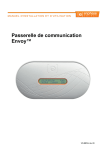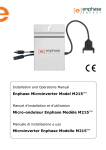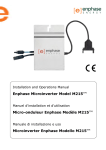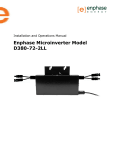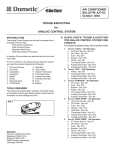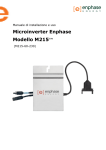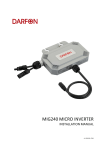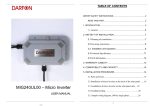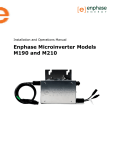Download Siemens TPS3 12 Operating instructions
Transcript
Installation and Operations Manual Siemens Microinverter Model SMIINV215R60XX Contact Information Siemens Industry, Inc. Infrastructure & Cities Sector Low and Medium Voltage 5400 Triangle Parkway Norcross, GA 30092 1-800-241-4453 www.usa.siemens.com/microsolar [email protected] FCC Compliance This equipment has been tested and found to comply with the limits for a Class B digital device, pursuant to part 15 of the FCC Rules. These limits are designed to provide reasonable protection against harmful interference in a residential installation. This equipment generates, uses and can radiate radio frequency energy and, if not installed and used in accordance with the instructions, may cause harmful interference to radio communications. However, there is no guarantee that interference will not occur in a particular installation. If this equipment does cause harmful interference to radio or television reception, which can be determined by turning the equipment off and on, the user is encouraged to try to correct the interference by one or more of the following measures: • Reorient or relocate the receiving antenna. • Increase the separation between the equipment and the receiver. • Connect the equipment into an outlet on a circuit different from that to which the receiver is connected. • Consult the dealer or an experienced radio/TV technician for help. Changes or modifications not expressly approved by the party responsible for compliance may void the user’s authority to operate the equipment. Other Information Product information is subject to change without notice. All trademarks are recognized as the property of their respective owners. For Siemens Microinverter Warranty Terms and Conditions, see the Appendix on page 28 of this manual. © 2011 Siemens Industry, Inc. All rights reserved. Page 2 Copyright 2011 Siemens Industry, Inc. 141-00015, Rev 01 Table of Contents Important Safety Information ................................................................................ 4 Read this First ....................................................................................................4 Symbol Legend .................................................................................................. 4 Safety Instructions ............................................................................................... 4 The Siemens Microinver System ........................................................................... 4 How the Microinverter Works .................................................................................. 6 System Monitoring............................................................................................ 6 Optimal Reliability ............................................................................................ 6 Ease of Design ................................................................................................ 6 Siemens Microinverter Installation .......................................................................... 7 Compatibility and Capacity ..................................................................................... 7 Parts and Tools Required ...................................................................................... 8 Lightning Surge Suppression .................................................................................. 8 Installation Procedure ........................................................................................... 9 Step 1 – Measure AC at Service Entrance Conductors ................................................... 9 Step 2 – Install the AC Branch Circuit Junction Box ..................................................... 10 Step 3 – Position the Trunk and Drop Cabling ............................................................ 11 Step 4 – Attach the Microinverters to the Racking ....................................................... 12 Step 5 – Dress the Trunk and Drop Cable ................................................................ 13 Step 7 – Terminate the unused end of the Trunk and Drop Cable .................................... 15 Step 8 – Connect the Cable to Junction Box(es) ......................................................... 16 Step 9 – Ground the System ................................................................................ 17 Step 10 – Complete the Installation Map .................................................................. 18 Complete the Siemens Map .............................................................................. 18 Alternative: Create Your Own Map ..................................................................... 18 Step 11 – Connect the PV Modules ........................................................................ 18 Step 12 – Build the Virtual Array ............................................................................ 19 Commissioning and Operation ............................................................................ 20 Commissioning................................................................................................. 20 Operating Instructions ........................................................................................ 20 Troubleshooting ............................................................................................. 21 Status LED Indications and Error Reporting .............................................................. 21 Startup LED Operation: .................................................................................... 21 Ground Fault Detection Indicator (GFDI) Fault: ....................................................... 21 Other Faults: ................................................................................................ 21 Troubleshooting an Inoperable Microinverter ............................................................. 22 Disconnecting a Microinverter from the PV Module ...................................................... 23 Installing a Replacement Microinverter .................................................................... 24 Technical Data ............................................................................................... 25 Technical Considerations .................................................................................... 25 Technical Specifications ...................................................................................... 26 Siemens SMIINV215R60XX Microinverter Operating Parameters ................................. 26 Appendix ...................................................................................................... 28 Limited Warranty............................................................................................... 28 Siemens Installation Map .................................................................................... 30 Sample Wiring Diagram – SMIINV215R60XX, 240 Vac or 208 Vac Single Phase ................. 31 Sample Wiring Diagram – SMIINV215R60XX, 208 Vac ................................................ 32 Page 3 Copyright 2011 Siemens Industry, Inc. 141-00015, Rev 01 Important Safety Information Read this First This manual contains important instructions for use during installation and maintenance of the Siemens SMIINV215R60 SMIINV215R60XX Microinverter. Symbol Legend To reduce the risk sk of electrical shock, and to ensure the safe installation and operation of the Siemens Microinverter, the following safety symbols appear throughout this document to indicate dangerous conditions and important safety instructions. DANGER Hazardous vo voltage. ltage. Will cause death or serious injury. Turn off Power before working on this equipment. This indicates a situation where the present voltage could cause injury or death. Extreme caution is required when servicing or installing the equipment referenced. nced. WARNING!! This indicates a situation where failure to follow instructions may be a safety hazard or cause equipment malfunction. Use extreme caution and follow instructions carefully. NOTE:: This indicates information particularly important for optimal system operation. Follow instructions closely. Safety Instructions Page 4 Perform all electrical installations in accordance with all local electrical codes and the R National Electrical Code (NEC), ANSI/NFPA 70. Be aware that only qualified personnel sshould install and/or replace Siemens Microinverters. Do not attempt to repair the Siemens Microinverter; it contains no user-serviceable serviceable parts. If it fails, please contact Siemens customer service to obtain an RMA number and start the replacement process. Tampering with or opening the Siemens Microinverter will void the warranty. Before installing or using the Siemens Microinverter, please read all instructions and cautionary markings in the technical description and on the Siemens Microinverter System and the Photovoltaic (PV PV) array. Connect the Siemens Microinverter to the electrical utility grid only after receiving prior approval from the utility company. Be aware that the body of the Siemens Microinverter is the heat sink and can reach a temperature of 80° C (176 (176° F). To reduce risk of burns, do not touch. Do NOT disconnect the PV module from the Siemens Microinverter without first removing AC power. Disconnect AC power by disengaging the circuit breaker or disconnect before the first inverter connection. Copyri Copyright 2011 Siemens Industry, Inc. 141-00015, Rev 01 The Siemens Microinverter System The Siemens Microinverter System is the world’s most technologically advanced inverter system for use in utility-interactive applications. This manual details the safe installation and operation of the Siemens Microinverter. The three key elements of a Siemens Microinverter System are: • the Siemens Microinverter • the Envoy™ Communications Gateway • the Enlighten™ web-based monitoring and analysis system This integrated system maximizes energy harvest, increases system reliability, and simplifies design, installation and management. Page 5 Copyright 2011 Siemens Industry, Inc. 141-00015, Rev 01 How the Microinverter Works The Siemens Microinverter maximizes energy production from your photovoltaic (PV) array. Each Siemens Microinverter is individually connected to one PV module in your array. This unique configuration means that an individual Maximum Power Point Tracker (MPPT) controls each PV module. This ensures that the maximum power available from each PV module is exported to the utility grid regardless of the performance of the other PV modules in the array. That is, although individual PV modules in the array may be affected by shading, soiling, orientation, or module mismatch, the Siemens Microinverter insures top performance for its associated PV module. The result is maximum energy production from your PV system. System Monitoring Indoors, you can install the Envoy Communications Gateway by plugging it into any convenient 120Vac wall socket and providing an Ethernet connection to your broadband router or modem. After installation of the Envoy, the Siemens Microinverters automatically begin reporting to the Enlighten web server. The Enlighten software presents current and historical system performance trends, and it informs you when the PV system is not performing as expected. Optimal Reliability Microinverter systems are inherently more reliable than traditional inverters. The distributed nature of a microinverter system ensures that there is no single point of system failure in the PV system. Siemens Microinverters are designed to operate at full power at ambient temperatures as high as 65° C (150° F). The inverter housing is designed for outdoor installation and complies with the NEMA 6 environmental enclosure rating standard: NEMA 6 rating definition: Indoor or outdoor use primarily to provide a degree of protection against hose-directed water, and the entry of water during occasional temporary submersion at a limited depth, and damage from external ice formation. Ease of Design PV systems using Siemens Microinverters are very simple to design and install. You will not need string calculations, and you can install individual PV modules in any combination of module quantity, type, age and orientation. You won’t need to install cumbersome centralized or string inverters. Each microinverter quickly mounts on the PV racking, directly beneath each PV module. Low voltage DC wires connect from the PV module directly to the co-located microinverter, eliminating the risk of personnel exposure to dangerous 600 Vdc power. Page 6 Copyright 2011 Siemens Industry, Inc. 141-00015, Rev 01 Siemens Microinverter Installation Follow the instructions in this section to install Siemens SMIINV215R60XX Microinverters. DANGER Hazardous voltage. Will cause death or serious injury. Turn off Power before working on this equipment. Be aware that installation of this equipment includes risk of electric shock. Normally grounded conductors may be ungrounded and energized when a ground fault is indicated. WARNING: Before installing the Siemens Microinverter, read all instructions and cautionary markings in the user manual, on the Siemens Microinverter, and on the photovoltaic array. WARNING: Perform all electrical installations in accordance with all local R electrical codes and the NEC , ANSI/NFPA 70. WARNING: Connect the Siemens Microinverter to the electrical utility grid only after receiving prior approval from the utility company. WARNING: Be aware that only qualified personnel should connect the Siemens Microinverter to the electrical utility grid. Compatibility and Capacity The Siemens SMIINV215R60XX Microinverters are electrically compatible with most 60-cell PV modules. For more information, see Technical Data page 25 of this manual. Refer to the Siemens website (http://www.usa.siemens.com/microsolar) for a list of electricallycompatible PV modules and approved PV module racking systems. To ensure mechanical compatibility, be sure to order the correct connector type for both microinverter and PV module from your distributor. Electrical Compatibility Model Number Works with PV Module Type Module Connector Type SMIINV215R60MC 60 cell MC-4 Type 2 Locking or Amphenol H4 Locking SMIINV215R60TY 60 cell Tyco Solarlock Locking Voltage and Capacity Maximum number of SMIINV215R60XXs per 20 amp AC Branch Circuit Service type Max SMIINV215R60XXs Max PV modules per branch per branch Page 7 Single phase 240 V or 208 V 17 17 Three phase 208 V 25 25 Copyright 2011 Siemens Industry, Inc. 141-00015, Rev 01 Parts and Tools Required In addition to the SMIINV215R60XX microinverters, PV modules, racking, and associated ass hardware, you will need the following items. Siemens equipment: • Trunk and Drop cabling, as needed • • • • • NOTE: Order the correct Trunk and Drop Cable type. Installers must order cable for either split phase 240 VAC, typical for residential applications applications,, or three phase 208 VAC, typical for commercial installations. All drop connectors on the Trunk and Drop Cable bear labels indicating the cable voltage designation. Use split phase 240 VAC cable at sites with 208 single phase service. Grounding clips Drop connector seals, as needed (for any unused drops on Trunk and Drop Cabling) Cabling Terminator caps, as needed (for unused ends of Trunk and Drop Cabling) Cabling Trunk and Drop disconnect tool (a number 3 Phillips screwdriver can be substituted) Other items: unction box • Appropriate junction • Continuous grounding conductor, grounding washers • Number 2 Phillips screwdriver • Torque wrench, sockets, wrenches for mounting hardware • Adjustable wrench or open open-ended wrench (for terminator caps) • Tool for PV module locking connectors • Mechanics cs mirror (for viewing indicator lights on the undersides of the microinverters) Lightning Surge Suppression Lightning does not actually need to strike the equipment or building where the PV system is installed to cause damage. Often, a strike nearby wil willl induce voltage spikes in the electrical grid that can damage equipment. Siemens Microinverters have integral surge protection, greater than most traditional inverters. However, if the surge has sufficient energy, the protection built into the Microinverter er can be exceeded, and the equipment can be damaged. As the Siemens Limited Warranty does not cover “acts of God” such as lightning strikes, and since lightning strikes can occur anywhere, it is best practice to install surge protection as part of any solar lar installation. We recommend the following protection devices. These have been tested to ensure that they do not interfere with power line communications. Install per vendor instructions. Vendor: Siemens, Part Number Number: TPS3 03 Application:: Residential 12 120/240V Split Phase where a Neutral to Ground (N-G G) bond exists. Vendor: Siemens, Part Number Number: TPS3 12 Application: Commercial branch panel protection (See the vendor datasheet for th these models at http://www.usa.siemens.com/tvss usa.siemens.com/tvss ). Page 8 Copyri Copyright 2011 Siemens Industry, Inc. 141-00015, Rev 01 Installation Procedure Installing the Siemens Microinverter System involves several key steps. Each step listed below is detailed in the following pages. Step 1 – Measure V VAC at Service Entrance Conductors Step 2 – Install the AC Junction Box Step 3 – Position the Trunk and Drop Cabling Step 4 – Attach the Microinverters to the Racking Step 5 – Dress the Trunk and Drop Cable Step 6 – Connect the Microinverters Step 7 – Terminate the unused end of the Trunk and Drop Cable Step 8 – Connect the Cable to AC Junction Box(es) Step 9 – Ground the System Step 10 – Complete the Paper Map Step 11 – Connect the PV Modules Step 12 – Build the Virtual Array DANGER Hazardous voltage. Will cause death or serious injury. Turn off Power before be working on this equipment. DO NOT connect Siemens Microinverters to the utility grid until you have completed all of the installation procedures as described in the following sections. Step 1 – Measure AC at Service Entrance Conductors Measure AC line voltage at the service entrance conductors to confirm AC service at the site. Acceptable ranges are shown in the following table. 120/240 VAC AC or 208Y/120 V VAC Single Phase Page 9 208Y/120 VAC Three Phase L1 to L2 211 to 264 Vac L1 to L2 to L3 183 to 229 Vac L1, L2 to neutral 106 to 132 Vac L1, L2, L3 to neutral 106 to 132 Vac Copyri Copyright 2011 Siemens Industry, Inc. 141-00015, Rev 01 Step 2 – Install the AC Branch Circuit Junction Box DANGER Hazardous voltage. Will cause death or serious injury. Turn off Power before working on this equipment. Do NOT exceed xceed the maximum number of microinverters in an AC branch circuit as listed on page 27 of this manual. You must protect each microinverter AC branch cir circuit with a 20 A maximum breaker. DANGER Hazardous voltage. Will cause death or serious injury. Turn off Power before working on this equipment. Size the AC wire gauge to account for voltage drop. All components of system wiring must be considered, including internal voltage drop within the length of Trunk and Drop cabling. WARNING! Only use electrical system components approved for wet locations. a. Size the AC wire gauge to account for voltage drop. Select the correct wire size based on the dist distance ance from the beginning of the microinverter AC branch circuit to the breaker in the load center. All components of system wiring must be considered, including internal voltage drop within the length of Trunk and Drop Cable. Typically, three wire sections and several wire terminations must be quantified. There is also some resistance associated with each circuit breaker. As all of these resistances are in series, they add together. Since the same current is flowing through each resistance, the total voltage drop is total current times the total resistance. For a single single-phase phase system, the total resistance is equal to two times the one one-way way resistance. For a three-phase three system, each of the three line currents and resistances must be calculated. Use the voltage drop charts at: http://www.usa.siemens.com/microsolar usa.siemens.com/microsolar to select the ®1 correct wire size. NEC guidelines for voltage drop on feeder and branch circuit conductors will not be adequate for microinverter bran branch ch circuits that contain the maximum allowable microinverters. b. Install an appropriate junction box at a suitable location on the PV racking system system. You can center feed the branch, or you can install the junction box at the end of a row of PV modules. c. Provide ide an AC connection from the junction box back to the utility interconnection using equipment and practices as R required by the NEC and local jurisdictions. 1 National Electrical Code is Registered Trademark of the National Fire Protection Association Page 10 Copyri Copyright 2011 Siemens Industry, Inc. 141-00015, Rev 01 Step 3 – Position the Trunk and Drop Cabling The cabling is a continuous length of 12 AWG, ou outdoor tdoor rated cable with a connector for each microinverter placed each PV module width. The microinverters plug directly into the cable, and the cable is terminated into the junction box that feeds electricity back to the system AC disconnect. WARNING! Make sure you using the correct cable type. Installers must order Trunk and Drop Cable for either 240 VAC single phase, typical for residential applications, or 208 VAC three phase, typical for commercial installations. All drop connectors on the cable bearr labels indicating the cable type. Installers can use 240 VAC cable at sites with 208 single phase service. a. Lay the Trunk and Drop cabling along the route it will travel, positioning the connectors so that they align with the PV modules. odules have a central stiffening brace. In these cases, do not position the NOTE: Many modules connector and microinverter at the exact center of the PV module. Instead position the drop connectors so that the connectors do not conflict with the braces b. Module widths vary by manufacturer. The connector cable spacing is designed for the widest PV modules compatible with Siemens Microinverters. If narrower modules are used, it may be necessary to account for excess cable by adding a ‘loop’ of cable at suitable intervals. Page 11 Copyri Copyright 2011 Siemens Industry, Inc. 141-00015, Rev 01 Step 4 – Attach the Microinverters to the Racking a. Mark the approximate centers of each PV module on the racking system. b. Evaluate the location of the microinverter with respect to the PV module junction box or any other obstructions. c. Ensure both that the micr microinverter does not interfere with the PV module frames or stiffening brace, and that the drop cable from the microinverter can easily reach the connector on the Trunk and Drop cable. DANGER Hazardous voltage. Will cause death or serious injury. Turn off Power before working on this equipment. Do NOT exceed the maximum number of microinverters in an AC branch circuit as listed on page 27 of this manual. ual. You must protect each microinverter AC branch circuit with a 20A maximum breaker. WARNING:: Allow a minimum of 1.9 cm (0.75 inches) between the roof and the bottom of the microinverter. Also allow 1.3 cm (0.50 inches) between the back of the PV module modul and the top of the inverter. Do not mount the microinverter in a location that allows longlong term exposure to direct sunlight (i.e., it should be covered by the PV module). d. Ground the microinverters using either a continuous, unbroken grounding conductor or approved grounding washers. If using grounding washers (e.g., WEEB) to ground the microinverter chassis to the PV module racking, choose a grounding washer that is approved for the racking manufacturer. Install one grounding washer per microinverter. To Torque rque the microinverter fasteners to the values below. • 1/4” mounting hardware – 45 lb-in minimum • 5/16” mounting hardware – 80 lb-in minimum NOTE:: Using a power screwdriver is not recommended due to risk of galling. Compatible grounding washer part numbers are included in the Racking Compatibility Application Note. Installation guidelines are included in the Grounding Washer Application Note. Refer to both documents at: http://www.usa.siemens.com/microsolar e. With the silver side of the microinverter facing up and the black side facing down, mount one microinverter at each of these locations using suitable hardware. The indicator light on the underside of the microinverter will be facing the roof. Page 12 Copyri Copyright 2011 Siemens Industry, Inc. 141-00015, Rev 01 Step 5 – Dress the Trunk and Drop Cable a. Attach the Trunk and Drop cabling to the rack using the recommended clips, or you may use tie wraps. The cable clips are designed so that the drop cable from the microinverter can also be dressed into the clip underneath the Trunk and Drop cable. NOTE:: There are two through through-holes holes in the trunk connector. These are not for mounting, but are used to disconnect the connector. Keep these release holes clear and accessible. b. Dress any excess cabling in loops so that it does not contact the roof. Do not leave the cabling to rest on the roof. There are several ways to support the cable. One method is to place tie wraps or clips on either side of the Trunk and Drop Connector. Use one or two additional clips, tie wraps, or other support scheme to secure the cable between connectors. Page 13 Copyri Copyright 2011 Siemens Industry, Inc. 141-00015, Rev 01 Step 6 – Connect the Microinverters a. Remove the temporary shipping cap from the Trunk and Drop Cable and connect the inverter. There are two latching mechanisms within the connectors. Listen for two clicks as the connectors engage. Ensure that both latching mechanisms have engaged. b. Repeat for all microinverters in the branch. c. Cover any unused connector with a sealing cap. Listen for two clicks as the connectors engage. Ensure that both latching mechanisms have engaged. Do not use the shipping cap to cover unused connectors. The shipping cap does not provide an adequate environmental seal. IP67 IP67-rated sealing caps are required for the system to be UL compliant and to protect against moisture ingress. NOTE:: Within the term “IP67”, “IP” indicates an Ingress Protection (IP) rating against dust and liquids. This specific rating of IP67 indicates that this connector protects against all dust particles and immersion in liquid. DANGER Hazardous vvoltage. Will cause death or serious injury. Turn off Power before working on this equipment. Make sure protective IP67 sealing caps have been installed on all unused AC connectors. Unused AC connectors are live when the system is energized by the utility system. NOTE:: If you need to remove an IP67 sealing cap. You must use the Siemens disconnect tool or a #3 Phillips screwdriver. Sealing caps may not be reused. Page 14 Copyri Copyright 2011 Siemens Industry, Inc. 141-00015, Rev 01 Step 7 – Terminate the unused end of the Trunk and Drop Cable You must terminate the far end of the Trunk and Drop cable. a. Remove 60mm (2.5 inches) of the outer jacket of the cable end. b. Take the screw-on gland portion of the cable terminator and run the cable end through it. c. Take the wire holder and run the cable end through it. d. Bend the individual wires back into the recesses in the wire holder so that they angle back toward the cable. e. Cut the individual wires so that no excess extends outside of the wire holder. The portion that angles back will need to extend enough to fit neatly into the 0.5 cm (0.2 in) slot in the wire holder and flush with the edge of the cap. f. Insert the wire holder into the cap, and screw the gland portion onto the cap. Ensure that the gland portion is rotating, not the cap. g. Hold the cap with an Siemens disconnect tool, or insert a #2 Phillips screwdriver. Hold the gland portion with a 24 mm (7/8”) wrench. Tighten the gland portion until the ratcheting feature on the cap bottoms out. h. Attach the terminated cable end to the racking using a clip or tie wraps so that the Trunk and Drop Cable and terminator do not touch the roof. i. Page 15 Ensure that all cabling is located underneath the PV module. Copyright 2011 Siemens Industry, Inc. 141-00015, Rev 01 Step 8 – Connect the Cable to Junction Box(es) a. Connect Trunk and Drop cable into the AC junction box using an appropriate gland or strain relief fitting. The trunk and drop cable requires a strain relief connector with an opening of 1.3 cm (0.5 inches) in diameter. b. Connect the TRUNK AND DROP cable into additional junction boxes as needed to transition to conduit between smaller sub-arrays. rrays. Refer to the wiring diagrams located in the Appendix of this manual for more information. NOTE: Wires are identified as follows: L1 is sheathed in Black, L2 is sheathed in red, L3 is sheathed in blue, Neutral is sheathed in white, and Ground is sheathed in green. The grounding wire is used to ground the microinverters. A WEEB or continuous ground is required in addition to this green grounding wire. 120/240 or 208Y/120 VAC SINGLE PHASE WIRING 208Y 208Y/120 VAC THREE PHASE WIRING Balanced 208 VAC three phase is accomplished by alternating phases es between microinverters as shown: NOTE:: The green wire acts as equipment ground. A continuous Grounding Electrode Conductor (GEC) for system ground is also required as described in the next step. Page 16 Copyri Copyright 2011 Siemens Industry, Inc. 141-00015, Rev 01 Step 9 – Ground the System If you are not using WEEB B grounding washers to ground the microinverter chassis as described in step 4, follow the step below. Each Siemens Microinverter comes with a ground clip that can accommodate a 6-8 8 AWG conductor. NOTE:: The AC output neutral is not bonded to ground inside the microinverter. a. Route a continuous GEC through each of the microinverters to the NEC AC grounding electrode. ®2 -approved b. You can ground the racking and module to this conductor using a crimp connection. An alternative method is to connect the micro microinverter to the grounded racking using a grounding washer approved for the racking. c. Torque the microinverter fasteners to the values below. • • 1/4” mounting hardware – 45 lb-in minimum 5/16” mounting hardware – 80 lb-in minimum NOTE:: Using a power screwdr screwdriver iver is not recommended due to risk of galling. 2 National Electrical Code is Registered Trademark of the National Fire Protection Association Page 17 Copyri Copyright 2011 Siemens Industry, Inc. 141-00015, Rev 01 Step 10 – Complete the Installation Map The Siemens Installation Map is a diagrammatic representation of the physical location of each microinverter in your PV installation. The virtual array in Enlighte Enlighten n is created from the map you create. Use the blank map in the Appendix to record microinverter placement for the system, or provide your own layout if a larger or more intricate installation map is required. Complete the Siemens Map a. Each Siemens Microinverter rter has a removable serial number label located on the mounting plate. Peel the removable serial number label from each Siemens Microinverter and affix it to the respective location on the Siemens installation map (see map in the Appendix Appendix). You can also download ownload installation maps and examples from www.usa.siemens.com/microsolar usa.siemens.com/microsolar.. Remember to keep a copy of the installation map for your records. Alternative: Create Your O Own Map a. Draw a top-down down view of the array using the Array Map template (using either the grid on Side A or the freeform area on Side B). Make sure to leave enough room to place the serial number stickers. b. When installing the microinverters, remove the serial number labels located next to the DC input cables and place them in the correct order on your drawing of the system. Remember to keep a copy of the installation map for your records. Step 11 – Connect the PV Modules NOTE:: Completely install all microinverters and all system inter-wiri wiring connections prior to installing the PV modules. a. Mount the PV modules above the microinverters. Each microinverter comes with two sets of oppositely sexed multi multicontact connectors. b. Mate the microinverters and PV modules as required. Repeat for all rema remaining PV modules using one microinverter for each module. WARNING: The M215 should be paired only with a 60-cell cell PV module. Page 18 Copyri Copyright 2011 Siemens Industry, Inc. 141-00015, Rev 01 Step 12 – Build the Virtual Array When the system is energized and all microinverters are detected by the Envoy Communications Communication Gateway, you can create the virtual array in Enlighten from the Siemens map you created. Once the virtual array is built, Enlighten displays a graphic representation of the PV system. It also shows detailed current and historical performance information. Please go to http://enlighten.enphase.com for more information on the Enlighten web-based based monitoring and analysis. a. Scan the paper installation map and upload it to the Activation form online. b. Use Array Builder to create the virtual array in Enlighten. Use the Installation nstallation map created in step 10 as your reference. NOTE: Go to http://enphase.com/support/videos/ to view an Array Builder demo. c. If you do not alread already have an account, please go to http://enlighten.enphase.com and click “Enlighten Login” to register. Page 19 Copyri Copyright 2011 Siemens Industry, Inc. 141-00015, Rev 01 Commissioning and Operation WARNING: Be aware that only qualified personnel must connect the Siemens Microinverter roinverter to the electrical utility grid. WARNING: Ensure that all AC and DC wiring is correct. Ensure that none of the AC and DC wires are pinched or damaged. Ensure that all junction boxes are properly closed. WARNING: Connect the Siemens Microinverter er to the electrical utility grid only after receiving prior approval from the utility company. NOTE: The Status LED of each microinverter will blink green six times to indicate normal start-up up operation one minute after DC power is applied. Commissioning To commission the Siemens Microinverter PV system: 1. Turn ON the AC disconnect or circuit breaker on each microinverter AC branch circuit. 2. Turn ON the main utility utility-grid AC circuit breaker (if applicable). Your system will start producing power after a five-minute wait time. 3. The Siemens Microinverters will begin sending performance data over the power lines to the Envoy. The time required for all microinverters to report to the Envoy will vary with the number of microinverters in the system. The first units should s be detected within 15 minutes but the entire system could take hours to detect. 4. The SMIINV215R60 SMIINV215R60XX XX has field adjustable voltage and frequency trip points. If adjustments are required by your local utility, the installer can use the Envoy to Manage the he Grid Profile after all microinverters have been detected. For more information on Envoy operation, refer to the Envoy Installation and Operation Manual at http://www.usa.siemens.com/microsolar usa.siemens.com/microsolar. Operating ting Instructions The Siemens Microinverter is powered on when sufficient DC voltage from the module is applied. One minute after DC voltage is applied, the status LED blinks green six times indicating proper start–up. up. You may need to use a mechanics mirro mirrorr to view indicator lights on the undersides of the microinverters. Page 20 Copyri Copyright 2011 Siemens Industry, Inc. 141-00015, Rev 01 Troubleshooting Adhere to all the safety measures described throughout this manual. Qualified personnel can use the following troubleshooting steps if the PV system does not operate correctly. WARNING: Do not attempt to repair the Siemens Microinverter; it contains no userserviceable parts. If it fails, please contact Siemens customer service to obtain an RMA number and start the replacement process. Status LED Indications and Error Reporting Startup LED Operation: One minute after DC power is first applied to the microinverter, six short green blinks indicate a successful microinverter startup sequence. Six short red blinks after DC power is first applied to the microinverter indicate a failure during microinverter startup. Post-Startup LED Indications: Use a mechanics mirror to view indicator lights on the undersides of the microinverters: Flashing Green – Producing power and communicating with Envoy Flashing Orange – Producing power and not communicating with Envoy Flashing Red – Not producing power Solid Red – GFDI Fault Ground Fault Detection Indicator (GFDI) Fault: A solid red status LED when DC power has been cycled indicates the microinverter has detected a ground fault error. The LED will remain red and the fault will continue to be reported by the Envoy until the error has been cleared. The condition should clear with operator intervention unless conditions causing the event have not been remedied or if the failure is permanent. Follow the instructions in the Envoy Communications Gateway Installation and Operation Manual to clear this condition. Or, for assistance, contact Siemens customer support at 1800-241-4453 or at [email protected]. Other Faults: All other faults are reported to the Envoy. Refer to the Envoy Installation and Operation Manual for troubleshooting procedures. Page 21 Copyright 2011 Siemens Industry, Inc. 141-00015, Rev 01 Troubleshooting an Inoperable Microinverter WARNING: Be aware that only qualified personnel should troubleshoot the PV array or the Siemens Microinverter. DANGER Hazardous voltage. Will cause death or serious injury. Turn off Power before working on this equipment. Always disconnect AC power before disconnecting the PV module wires from the Siemens Microinverter. DANGER Hazardous voltage. Will cause death or serious injury. Turn off Power before working on this equipment. Never disconnect the DC wire connectors under load. Ensure that no current is flowing in the DC wires prior to disconnecting. An opaque covering may be used to cover the module prior to disconnecting the module. WARNING: The Siemens Microinverters are powered by DC power from the PV modules. Make sure you disconnect the DC connections and reconnect DC power to watch for the six short LED blinks one minute after DC is applied. To troubleshoot an inoperable microinverter, follow the steps in the order shown: 1. Check the connection to the utility grid and verify the utility voltage and frequency are within allowable ranges shown in the Technical Data section on page 25 of this manual. 2. Verify that AC line voltage at the service entrance conductors and at the junction box for each Siemens branch are within the ranges are shown in the following table: 120/240 VAC or 208Y/120 VAC Single Phase 208Y/120 VAC Three Phase L1 to L2 211 to 264 Vac L1 to L2 to L3 183 to 229 Vac L1 to neutral L2 to neutral 106 to 132 Vac L1 to neutral L2 to neutral L3 to neutral 106 to 132 Vac 3. Verify utility power is present at the inverter in question by removing AC, then DC power. Never disconnect the DC wires while the microinverter is producing power. Re-connect the DC module connectors. After one minute, watch for six short LED blinks. 4. Check the AC branch circuit interconnection harness between all the microinverters. Verify that each inverter is energized by the utility grid as described in the previous step. 5. Make sure that any upstream AC disconnects, as well as the dedicated circuitbreakers for each microinverter branch circuit, are functioning properly and are closed. 6. Verify the PV module DC voltage is within the allowable range shown in the Technical Data section on page 25 of this manual. 7. Check the DC connections between the microinverter and the PV module. 8. If the problem persists, please call Siemens customer support at 1-800-241-4453 or at [email protected]. Page 22 Copyright 2011 Siemens Industry, Inc. 141-00015, Rev 01 Disconnecting a Microinverter from the PV Module To ensure the microinverter is not disconnected from the PV modules under load, adhere to the following disconnection steps in the order shown: 1. Disconnect the AC by opening the branch circuit breaker. DANGER Hazardous voltage. Will cause death or serious injury. Turn off Power before working on this equipment. Disconnect the Siemens Microinverter from the electrical utility grid prior to servicing. 2. Disconnect the first AC connector in the branch circuit. The Siemens Microinverter AC connectors are tool-removable only. To disconnect a microinverter from the Trunk and Drop Cable, insert the two large prongs of the disconnect tool (shown below) into the two holes in the drop connector. Rock the connector back and forth while pulling gently to disengage. If the disconnect tool is not available, insert a #3 Phillips screwdriver into one hole, and rock that side of the drop connector out. Then, insert the screwdriver into the other hole and pull the connector out entirely. 3. Cover the module with an opaque cover. 4. Using a DC current probe, verify there is no current flowing in the DC wires between the PV module and the microinverter. 5. Care should be taken when measuring DC currents due to the fact that most clampon meters must be zeroed first and tend to drift with time. 6. Disconnect the PV module DC wire connectors from the microinverter. 7. Remove the microinverter from the PV array racking. DANGER Hazardous voltage. Will cause death or serious injury. Turn off Power before working on this equipment. Do not leave the drop connector uncovered for an extended period. If you do not plan to replace the microinverter immediately, you must cover any unused connector with a sealing cap. Listen for two clicks as the connectors engage. Ensure that both latching mechanisms have engaged. Note that the shipping cap does not provide an adequate environmental seal. IP67-rated sealing caps are required for the system to be UL compliant and to protect against moisture ingress. Page 23 Copyright 2011 Siemens Industry, Inc. 141-00015, Rev 01 Installing a Replacement Microinverter 1. With the silver side of the microinverter facing up and the black side facing down, attach the replacement microinverter to the PV module racking using hardware recommended by your module racking vendor. 2. If you are using grounding washers (e.g., WEEB) to ground the chassis of the microinverter, the old grounding washer should be discarded, and a new grounding washer must be used w when hen installing the replacement microinverter. Torque the microinverter fasteners to the values below. • 1/4” mounting hardware – 45 lb-in minimum • 5/16” mounting hardware – 80 lb-in minimum NOTE:: Using a power screwdriver is not recommended due to risk of galling. ga 3. If you are using a grounding electrode conductor to ground the microinverter chassis, attach the grounding electrode conductor to the microinverter ground clamp. 4. Remove the sealing cap from the Trunk and Drop Cable and connect the inverter. There are e two latching mechanisms within the connectors. Listen for two clicks as the connectors engage. Ensure that both latching mechanisms have engaged. 5. Mount the PV module above the microinverter. Each microinverter comes with two sets of oppositely sexed mul multi-contact connectors. 6. Mate the microinverters and PV modules as required. Repeat for all remaining PV modules using one microinverter for each module. 7. Energize the branch circuit breaker, and verify operation of the replacement microinverter by checking tthe he indicator light on the underside of the microinverter. You may need a mechanics mirror to see the indicator light. 8. Initiate a device scan at the Envoy. To do this, press and hold the Menu button on Envoy for two seconds to bring up the Envoy menu on the LCD window. When the LCD window displays “Enable Communication Check”, release the Menu button. 9. Use Enlighten’ss Array Builder function to add the newly detected microinverter to the virtual array. Page 24 Copyri Copyright 2011 Siemens Industry, Inc. 141-00015, Rev 01 Technical Data Technical Considerations The Siemens SMIINV215R60XX Microinverters are designed to operate with most 60-cell PV modules. Be sure to verify the voltage and current specifications of your PV module match those of the microinverter. For more information, refer to the Siemens website (http://www.usa.siemens.com/microsolar) for a list of compatible PV module racking systems and PV modules. WARNING: You must match the DC operating voltage range of the PV module with the allowable input voltage range of the Siemens Microinverter. WARNING: The maximum open circuit voltage of the PV module must not exceed the specified maximum input voltage of the Siemens Microinverter. The output voltage and current of the PV module depends on the quantity, size and temperature of the PV cells, as well as the solar insolation on each cell. The highest PV module output voltage occurs when the temperature of the cells is the lowest and the module is at open circuit (not operating). The maximum short circuit current rating of the module must be equal to or less than the maximum input DC short circuit current rating of the microinverter. A list of compatible PV modules is maintained on the Siemens website (http://www.usa.siemens.com/microsolar). Page 25 Copyright 2011 Siemens Industry, Inc. 141-00015, Rev 01 Technical Specifications Siemens SMIINV215R60XX Microinverter Operating Parameters Topic Unit Min Typical Max MPPT voltage range V 22 29 36 Operating Range V 16 Maximum DC input voltage V Minimum / Maximum start voltage V Maximum DC input short circuit current A 15 Maximum DC input current A 10.5 mA 1000 A 0 DC Operating Parameters Ground fault protection Maximum input source backfeed current to input source 36 45 22 45 AC Operating Parameters Maximum AC output Power (-40 to 65 °C) W Output power factor 215 0.95 0.99 1 Nominal AC output voltage range 240 Vac 208 Vac Vrms Vrms 211 183 240 208 264 229 Extended AC output voltage range 240 Vac 208 Vac Vrms Vrms 206 179 240 208 269 232 Maximum AC output current 240 Vac 208 Vac A A Nominal AC output frequency range Hz 59.3 60 60.5 Extended AC output frequency range Hz 59.2 60 60.6 Maximum AC output over current protection A 20 A Maximum AC output fault current & duration Apeak, ms 25.2 Apeak over 1.74 ms ARMS, Cycles 1.05 ARMS over 3 cycles 1.04 ARMS over 5 cycles 0.9 1.0 High AC Voltage trip limit accuracy % ±2.5 Low AC Voltage Trip limit accuracy % ±4.0 Frequency trip limit accuracy Hz ±0.1 Trip time accuracy ms ±33 Page 26 Copyright 2011 Siemens Industry, Inc. 141-00015, Rev 01 Siemens SMIINV215R60XX Microinverter Operating Parameters Topic Unit Miscellaneous Operating Parameters Min Inverters per 20 amp AC branch circuit 240 Vac or 208 Vac Single Phase 208 Vac Three phase Typical 1 1 Max 17 25 Peak inverter efficiency % 96.3 CEC weighted efficiency % 96.0 Static MPP tracking efficiency (weighted EN 50530) % 99.6 Total Harmonic Distortion % Ambient temperature range °C Night Tare Loss 3.0 -40 65 mW Storage temperature range °C 5 46 -40 65 Features 3 Dimensions not including mounting bracket (approximate) 17.3 cm x 16.4 cm x 2.5 cm (6.8” x 6.45” x 1.0”) Weight 3.5 Lbs Enclosure environmental rating NEMA 6 Cooling Convective – no fan Communication Power line Standard warranty term 25 years, limited Applicable Standards UL1741, IEEE1547, FCC Part 15 Class B, CAN/CSA-C22.2 NO. 0-M91, 0.4-04, and 107.1-01 Integrated AC disconnect The AC connector has been evaluated and approved for use as the load-break ®3 disconnect required by the NEC . National Electrical Code is Registered Trademark of the National Fire Protection Association Page 27 Copyright 2011 Siemens Industry, Inc. 141-00015, Rev 01 Appendix Limited Warranty Siemens Industry Inc. ("Siemens") has developed a highly reliable Microinverter that is designed to withstand normal operating conditions when used for its originally intended purpose in compliance with the Siemens User Manual supplied with the originally shipped system. The Siemens limited warranty (“Limited Warranty”) covers defects in workmanship and materials of the Siemens Microinverter (“Defective Product”) for a period of twenty-five (25) years from the date of original purchase of such Microinverter at point of sale to the originally-installed end user location (the "Warranty Period"). During the Warranty Period, the warranty is transferable to a different owner as long as the Microinverter remains installed at the originally-installed end user location. During the Warranty Period, Siemens will, at its option, repair or replace the Defective Product free of charge, provided that Siemens through inspection establishes the existence of a defect that is covered by the Limited Warranty. Siemens will, at its option, use new and/or reconditioned parts in repairing or replacing the Defective Product. Siemens reserves the right to use parts or products of original or improved design in the repair or replacement of Defective Product. If Siemens repairs or replaces a Defective Product, the Limited Warranty continues on the repaired or replacement product for the remainder of the original Warranty Period or ninety (90) days from the date of Siemens’s return shipment of the repaired or replacement product, whichever is later. The Limited Warranty covers both parts and labor necessary to repair the Defective Product, but does not include labor costs related to un-installing the Defective Product or re-installing the repaired or replacement product. The Limited Warranty also covers the costs of shipping repaired or replacement product from Siemens, via a non-expedited freight carrier selected by Siemens, to locations within the United States (including Alaska and Hawaii) and Canada, but not to other locations outside the United States or Canada. The Limited Warranty does not cover, and Siemens will not be responsible for, shipping damage or damage caused by mishandling by the freight carrier and any such damage is the responsibility of the freight carrier. To obtain repair or replacement service under this Limited Warranty, the customer must comply with the following policy and procedure: All Defective Product must be returned with a Return Merchandise Authorization Number (RMA) which customer must request from Siemens. Before requesting the RMA, however, the customer should contact a Siemens technical support (1-800-241-4453) representative to evaluate and troubleshoot the problem while the Siemens Microinverter is in the field, since many problems can be solved in the field. Page 28 If in-field troubleshooting does not solve the problem, Customer may request the RMA number, which request must include the following information: - Proof-of-purchase of the Defective Product in the form of (1) the dated purchase receipt from the original purchase of the product at point of sale to the end user, or (2) the dated dealer invoice or purchase receipt showing original equipment manufacturer (OEM) status, or (3) the dated invoice or purchase receipt showing the product exchanged under warranty. - Model number of the Defective Product - Serial number of the Defective Product - Detailed description of the defect - Shipping address for return of the repaired or replacement product All Defective Product authorized for return must be returned in the original shipping container or other packaging that is equally protective of the product Copyright 2011 Siemens Industry, Inc. 141-00015, Rev 01 The returned Defective Product must not have been disassembled or modified without the prior written authorization of Siemens Siemens Microinverters are designed to withstand normal operating conditions and typical wear and tear when used for their original intent and in compliance with the installation and operating instructions supplied with the original equipment. The Limited Warranty does not apply to, and Siemens will not be responsible for, any defect in or damage to any Siemens Microinverter: (1) that has been misused, neglected, tampered with, altered, or otherwise damaged, either internally or externally; (2) that has been improperly installed, operated, handled or used, including use under conditions for which the product was not designed, use in an unsuitable environment, or use in a manner contrary to the Siemens User Manual or applicable laws or regulations; (3) that has been subjected to fire, water, generalized corrosion, biological infestations, acts of God, or input voltage that creates operating conditions beyond the maximum or minimum limits listed in the Siemens Microinverter specifications, including high input voltage from generators or lightning strikes; (4) that has been subjected to incidental or consequential damage caused by defects of other components of the solar system; or (5) if the original identification markings (including trademark or serial number) of such Microinverter have been defaced, altered, or removed. The Limited Warranty does not cover costs related to the removal, installation or troubleshooting of the customer's electrical systems. The Limited Warranty does not extend beyond the original cost of the Siemens Microinverter. THE LIMITED WARRANTY IS THE SOLE AND EXCLUSIVE WARRANTY GIVEN BY SIEMENS AND, WHERE PERMITTED BY LAW, IS MADE EXPRESSLY IN LIEU OF ALL OTHER WARRANTIES, EXPRESS OR IMPLIED, STATUTORY OR OTHERWISE, INCLUDING, WITHOUT LIMITATION, WARRANTIES OF TITLE, QUALITY, MERCHANTABILITY, FITNESS FOR A PARTICULAR PURPOSE OR NON-INFRINGEMENT OR WARRANTIES AS TO THE ACCURACY, SUFFICIENCY OR SUITABILITY OF ANY TECHNICAL OR OTHER INFORMATION PROVIDED IN MANUALS OR OTHER DOCUMENTATION. IN NO EVENT WILL SIEMENS BE LIABLE FOR ANY SPECIAL, DIRECT, INDIRECT, INCIDENTAL OR CONSEQUENTIAL DAMAGES, LOSSES, COSTS OR EXPENSES HOWEVER ARISING, WHETHER IN CONTRACT OR TORT, INCLUDING WITHOUT LIMITATION ANY ECONOMIC LOSSES OF ANY KIND, ANY LOSS OR DAMAGE TO PROPERTY, OR ANY PERSONAL INJURY. To the extent any implied warranties are required under applicable law to apply to the Siemens Microinverter, such implied warranties shall be limited in duration to the Warranty Period, to the extent permitted by applicable law. Some states and provinces do not allow limitations or exclusions on implied warranties or on the duration of an implied warranty or on the limitation or exclusion of incidental or consequential damages, so the above limitation(s) or exclusion(s) may not apply. This Limited Warranty gives the customer specific legal rights, and the customer may have other rights that may vary from state to state or province to province. Page 29 Copyright 2011 Siemens Industry, Inc. 141-00015, Rev 01 Siemens Installation Map Page 30 Copyri Copyright 2011 Siemens Industry, Inc. 141-00015, Rev 01 Sample Wiring Diagram – SMIINV215R60XX, 240 Vac or 208 Vac Single Phase Page 31 Copyright 2011 Siemens Industry, Inc. 141-00015, Rev 01 Sample Wiring Diagram – SMIINV215R60XX, 208 Vac Page 32 Copyright 2011 Siemens Industry, Inc. 141-00015, Rev 01 Siemens Industry, Inc. Infrastructure & Cities Sector Low and Medium Voltage 5400 Triangle Parkway Norcross, GA 30092 1-800-241-4453 www.usa.siemens.com/microsolar [email protected]



































